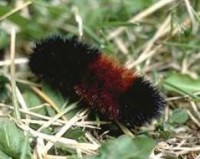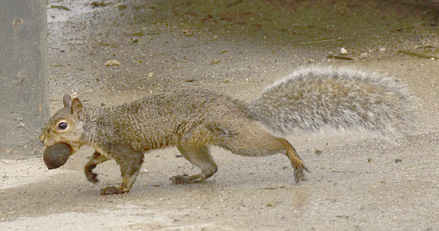It might seem early to be thinking about winter in summer and autumn, but in the world of weather lore, traditions and beliefs were based on observations of the environment and the preceding weather. Much weather lore is based on the effects we can observe in changes with insects, animals, birds, plants and people.
 One example that has been used for many years is checking the black bands on a woolly bear caterpillar. Weather folklore suggests that the colors predict the upcoming winter.
One example that has been used for many years is checking the black bands on a woolly bear caterpillar. Weather folklore suggests that the colors predict the upcoming winter.
Those early New World Colonists knew the woolly bear, a brownish-black caterpillar, which is still a pretty common sight inching across roads and surfaces on warm days. The caterpillar hatches from an egg in warm weather months, eats until fall and then they seek winter shelter until spring.
Woolly bears have 13 segments which are colored black and reddish-brown. Weather lore says that says those colors predict the upcoming winter and that the wider a woolly bear’s middle brown section, the milder the winter. On the other hand, if there is more black than brown, the upcoming winter should prove harsh.
Scientists pretty much dismiss almost all weather folklore including this caterpillar’s weather-predicting ability. Their research shows that a better growing season in nature means a woolly bear grows too. When it comes to coloring, that seems to be based on age. As it ages, a caterpillar sheds its outer layer up to six times before reaching adult size. Each time it molts, it becomes less black and more reddish. So old caterpillars mean a mild winter. (By the way, that caterpillar will spin a cocoon next spring and then emerge as an Isabella tiger moth.)

Of course, that doesn’t mean that there is no truth to all the weather lore passed on for generations.
So, turn on your recent memory and see what you can recall of these traditional winter weather indicators from the past weeks and months.
- If ant hills are high in July, winter will be snowy.
- If the first week in August is unusually warm, the coming winter will be snowy and long.
- For every fog in August, there will be a snowfall in winter.
- If a cold August follows a hot July, it foretells a winter hard and dry.
- When leaves fall early, fall and Winter will be mild. When leaves fall late,winter will be severe.
- Squirrels gathering nuts in a flurry, will cause snow to gather in a hurry. And when squirrels’ tails are very bushy, that’s a sign of a tough winter to come.
- Much rain in October, much wind in December.
- A warm October, a cold February.
- For farmers, a tough Winter is ahead if corn husks are thick and tight. The same applies for apple skins. And when onion skins are very thin,
a mild Winter coming in. But onion skins thick and tough, the coming Winter cold and rough. - Ironically, more signs of a rough winter are when berries and nuts are plentiful.
- When bees build their nests high in the trees, they expect a hard winter.
And some signs that are still to come…
- Full Moon in October without frost, then no frost ‘until November’s Full Moon.
- Flowers bloomin’ in late Autumn, A sure sign of a bad Winter comin’.
- A warm November is the sign of a bad Winter.
- As high as the weeds grow, So will the bank of snow.
- Thunder in the Fall foretells a cold Winter.
- Check back in at the year’s end to see if it’s true that a green Christmas means a white Easter, and if there’s thunder during Christmas week, the Winter will be anything but meek.
What have you observed so far in your piece of the world?
Yep, bad winter this year, though we did have a bad Nov., but warm Dec. here in MI.
LikeLike
The trees are still green in Virginia – no color and haven’t fallen yet. Lots of fog thick as pea soup.
LikeLike
I really loved reading this post. I like you to post this on Facebook. Its so true. Gods so wonderful for this gift you have written Bless you. Your Gifted. God be with you always. Amen
LikeLike
No one saw last year’s snowy DECEMBER coming before it hit! And snow remained on the ground until March. If we get snow in this tiny village in Southeastern Washington State, it is usually in January. But some of the “old timers”, which, frankly, is over half the population, say that our town used to get snows like that; it was a blast from the past and it made for a delightful winter. And folks really appreciated the Spring when it finally came. And good yields for the crops!
LikeLike
I go by the mountain ash trees , they were absolutely loaded last year. This year there’s not as many, so I think we won’t have an overly cold winter.
LikeLike
Ash trees are a new “sign” to me. I’ll have to check them out in my area.
LikeLike